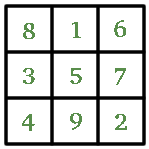An introduction to magic squares
Magic Squares are square grids with a special arrangement of numbers in them. These numbers are special because every row, column and diagonal adds up to the same number. So for the example below, 15 is the magic number. Could you work this out just from knowing that the square uses the numbers from 1 to 9?
Image

Also, the two numbers that are opposite each other across the centre number will add up to the same number. So in the square above, 8 + 2 = 10 , 6 + 4 = 10, 1 + 9 = 10 and 3 + 7 = 10. Why is this?
The "order" of a magic square tells how many rows or columns it has. So a square with 3 rows and columns is Order 3, and a square with 4 rows and columns is Order 4 and so on. If you'd like to find out more about how to make up your own magic squares, and the mathematics behind it all, you can go to some other pages on the website such as Magic Squares and Magic Squares II .
But why are they called magic?
So the numbers in the Magic Square are special, but why are they called magic? It seems that from ancient times they were connected with the supernatural and magical world. The earliest record of magic squares is from China in about 2200 BC. and is called "Lo-Shu". There's a legend that says that the Emperor Yu saw this magic square on the back of a divine tortoise in the Yellow River.
Image

You can make similar magic squares, of order 3, using different numbers. Can you see any patterns in the numbers that work?
Reference:
The Joy of Mathematics by T. Pappas
